
Plague Quarantine Page Menu: 1 2 3 4 5 6 7 8 9 10 11 12 13 14 15 Next>>
Golden Age of Piracy Maritime Quarantine For Plague, Page 14
History of Quarantine Regulations - Bubonic Plague: England
While England never completed any formal lazarettos, they did establish locations for crews to serve out quarantines on their ships as well as occasionally finding unoccupied land where cargoes could be opened and aired to eliminate any contagion. The history of the plague in England goes at least back to 1348, arriving in "the sea-port towns of Dorsetshire; thence to have palled into
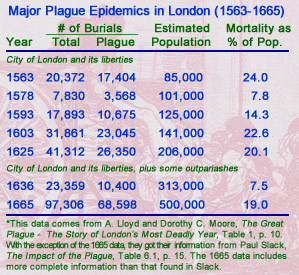
Image: Francisco de Goya, Cartloads to the cemetery, (1812-5)
Devonshire and Somersetshire, as far as Bristol; and though the Gloucestershire people cut off all communication with that city, yet at length it reached Gloucester, Oxford and London."1 This was followed by England having to withstand numerous significant bouts of the bubonic plague. A list of the major plague epidemics experienced in London and the surrounding liberties (outlying areas overseen by London) including mortality statics is shown in the chart at right.
Beginning in the 16th century action was taken to prevent the plague from being imported into the country. Regulations were introduced in England in 1585.2 Other measures were implemented during the seventeenth century, although "imposition of quarantine was always short-lived, in response to perceived emergencies, and within the royal prerogative. There was as yet no question of permanent measure or of parliamentary involvement."3
The first temporary quarantine measure of the seventeenth century occured when the plague was reported to be present in the Netherlands and France in 1635. The Privy Council, advisors to the King, sent a letter to Lord Mayor Robert Parkhurst of London asking what should be done (implying that he should take action to prevent the disease from reaching England). Parkhurst answered, suggesting: "1. A proclamation inhibiting vessels to land without licence from the officers of customs. 2. That from infected places no liberty be given to land till some certain days be overpassed. 3. That on the arrival of any vessels waiters or guardians be put aboard to restrain [the crew from] landing."4
The Privy Council agreed with these suggestions and issued a proclamation in November of 1635 using
 17th century.jpg)
Panorama of Amsterdam Harbor (17th century)
terms similar to those suggested by Parkhurst. Historian John Booker notes that this was "the first time that a Proclamation to this effect had been issued - in England"5. He also explains that the first recorded use of quarantine in England occurred in 1638 when some ships coming from Morlaix in Brittany (modern France) were stopped in the English Channel and the "Customs officers stopped all linen ships from Morlaix unloading 'untill they have remayned upon ye River full fortie daies.'"6 Still, this was only a local, temporary response to the problem.
When the plague again appeared in Amsterdam in late 1663, the 1636 College Instructions were enjoined by royal authority in 1664.7 In a diary entry on November 26, 1663, Samuel Pepys explained that "The plague, it seems, grows more and more at Amsterdam; and we are going upon making of all ships coming from thence and Hambrough, or any other infected places, to perform their Quarantine (for thirty days as Sir Rd. Browne expressed it in the order of the Council...) in Holehaven"8.
Naval historian John Keevil explains some of the details of this order:
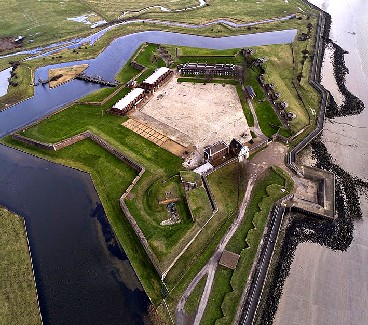
Photo: Mervyn Rands - Tilbury Fort on the Thames
...the Privy Council ordered that two small naval vessels be immediately appointed to anchor ‘as low in the River [Thames] as with assurance they may so speak with every ship that shall attempt to pass by and strictly examine from whence they come, and if they shall find any to come from Amsterdam, Hamburg or any other [plague] infected places, then peremptorily to command them to turn back to sea or to perform their Quarantine for 30 days in Hole Haven, and that order be given that the captains of his Majesty's said vessels be empowered to give passes to such as come from places free from infection.
The commanders of the Blockhouse at Gravesend and of Tilbury Fort were to allow no vessel to sail past them without this permit, and further "a little ketch manned with six men" was to lie at Hole Haven as a guard over the ships performing quarantine. Bills of health had been issued to English ships since the reign of James I, but only now was England rigorously applying those rules, introduced by Venice more than two hundred years earlier9
The Privy Council increased the quarantine period from thirty to forty days in 1664 because the illness in Amsterdam was getting worse.10 The regulations said, "Infected ships were to be sent to sea and ships from infected ports were to be moored under guard in a named creek of the Thames estuary and only released if free from infection after forty days, the goods meanwhile being 'aired' on shore."11
English Quarantine rules first appeared during the golden age of piracy in 1709 when a plague epidemic swept through nations around the Baltic Sea starting in 1708. Many English naval supplies came from this area and something had to be done to prevent the illness from reaching England. On August 22, 1709, the Privy Council of England, advisors to the sovereign, decided that
"The navy was to prevent any goods, seamen or passengers from those areas being landed in London or the outports 'untill they be under the Care of the Officers of the Customes who are to
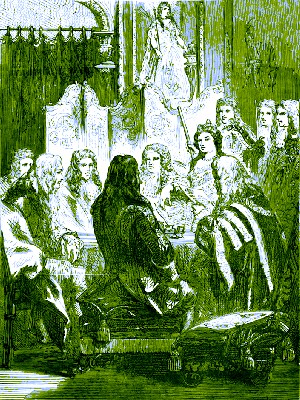
Queen Anne's Privy Council, From Cassells Illustrated
History of England, Vol. 4 (1864)
take Care ... according to the Intention of this Order'."12 This was too vague to be practicable, so another order was issued on September 5th, which added that such landing was to occur at locations "'provided for airing the ... Persons and Goods for 40 Days appointed for performing their Quarantain"13. This was also confusing because available locations were not identified. A third order was issued eight days later which did nothing to clarify the second, but added that the 'Baltic Seas' were considered an infected area.
Quarantine was made official by Queen Anne's 'Act to oblige Ships coming from Places infected more effectually to perform their Quarantine' in 1710. The Act was implemented because "several Places on or near the Baltick Sea are and have been, for some Time past, infested with the Plague, and her Majesty... required a Quarantine to be performed by all Ships and Persons coming from Places infected, as herein is directed". The act advised that quarantine was to be served "in such Place, &c. as shall be directed by her Majesty". People discovered leaving the ship before quarantine ended were to be put back aboard to finish their term. Those in charge of overseeing the quarantine were to keep watches and could "seize any Boat belonging to the Ship, and detain it during the Quarantine"14 Once the quarantine was completed, the ship was given a Certificate costing 1 s. The act ended with a quick mention of opening and airing imported goods which had been tacked on following discussion of the act in Parliament.
Like the Privy Council orders, the act was vague, providing neither the length of or locations for quarantine. It also lacked effective punishments for those breaking quarantine and didn't provide money to pay the people who were to be in charge of overseeing it and the watches. "A clumsier piece of legislation could scarcely have been imagined."15
For the British Navy "the imposition of quarantine was a thorough nuisance" because it tied up fleets needed to fight the French during the War of Spanish Succession, escort merchant fleets past French privateers, and capture French merchant ships for England.16 The new ruling saddled the navy with the additional tasks of supporting the Customs officers enforcing the law and providing guard-ships at the quarantine stations. In addition, the already undermanned naval vessels which had been in the Baltic were now required to perform quarantine, putting them out of action for forty days. News of plague in the Baltic continued through 1711, so the bill remained in place until 1714.17
After that, quarantine was again relaxed in England until

Artist: Sir Godfrey Kneller - King George I (1714)
the deadly plague outbreak in Marseilles, France in 1720. Since the King was out of the country, "the Lords Justices issued an Order which was a virtual resurrection of the texts used in the Baltic crisis"18. The justices asked esteemed physician Richard Mead for his advice, which resulted in his writing A short discourse concerning pestilential contagion. His suggested procedures were never fully employed, however.
In October of 1720, the Privy Council specified the establishment of quarantine ports for "London, Portsmouth, Plymouth, Falmouth and Bristol, and airing grounds were to be summarily appointed by local Customs."19 To enforce these orders, parliament's backing was required. On December 17th, 1720, the quarantine bill was ordered, the result of which which was read the 10th of January. It passed the 21st of January, and was endorsed by King George I on the 25th. "More pains and deliberation had been employed in preparing this act, than the former; and it consequently came out not only enlarged, but much improved."20.
The 1721 act began by explaining that the 1710 Act "is defective and insufficient for the Purposes intended, and the Penalties inflicted by the same not adequate to the Offences thereby prohibited". With this in mind, the new act spelled out more stringent penalties for men and ships who failed to work with the government and properly serve their quarantine. Those in charge "of any Vessel coming from infested Places, or having on board Persons visited with the Plague, and not discovering the
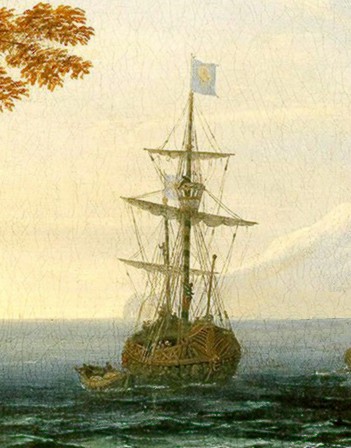
Artist: Claude Lorrain
Ship at Anchor, From The Abduction of Europa by Jupiter (17th c)
same, [were] Guilty of Felony." Failure to 'discover' such information to officials was also fined £200. Men who left the ship before their quarantine period expired were similarly fined, put back on the ship to serve out the rest of their quarantine and then jailed for 6 months. If the ship's master or captain let men leave a ship under quarantine or didn't take his ship to the place specified for quarantine, he forfeited his ship and was fined £200. Anyone not under quarantine who boarded a ship under quarantine was required to stay and serve. Ships with infected people or goods or coming from infected areas could also be burned at the king's discretion. Most chilling of all, people who escaped from quarantine and left the quarantine area, "shall suffer Death."21
The king could also set up 'Lines' around infected areas "and prohibit Persons, Goods, &c. to pass such Lines. Persons offering to pass without Licence, may be compelled back, and actually passing, shall suffer Death." Like the previous act, watches were to be set up around quarantine area. Watchmen failing to perform their duty or not following the quarantine rules would be fired and fined 100 £. The act also allowed for the creation of lazarettos upon an outbreak of plague in England. This read, "In Times of Infection the King may cause Ships and Lazarets to be provided for the Performance of Quarantine, and Entertainment of Persons infected; likewise proper Places for airing of Goods, &c."22 Fortunately, plague never again visited England, so no lazarettos were ever completed there.
In September of 1721, the Privy Council took specific action against France, telling the Attorney General, "to prepare an Order obliging all persons arriving in the country from the French coast north of Biscay, to bring a bill of health or be subject to quarantine."23 The King issued an Order and Proclamation to this effect in October
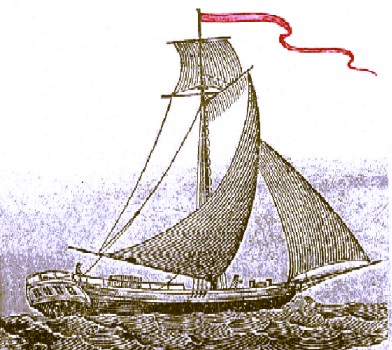
A Sloop Being Used as Packet Boat (1825)
which directed that "All persons on packet boats (vessels carrying mail and packages between places) ‘of what Condition or Quality soever they be’ were to produce their bill to the master before sailing, or the whole ship would be quarantined."24 As a result, "all ships arriving from the French Mediterranean and Atlantic coasts [were put] under quarantine, and all persons crossing the Channel [were] under the necessity to prove that they, and their port of departure, were healthy."25 Among the goods coming from Marseille which were quarantined were "kid skins, silk, cotton, human hair and other susceptible goods were regularly brought from Languedoc to Bordeaux and the Biscay ports."26 Such vessels were subject to a 40 day quarantine.
The quarantine orders again created problems for the English navy who were trying to stop smuggling: they could not board ships coming from these regions who did not have bills of health, so if they caught a ship suspected of smuggling, all the master had to do was say that they did not have the required health documents. At the same time, it hindered legitimate trading vessels who had to either show bills of health or go through the quarantine process and have their goods aired, delaying them as well as potentially causing their goods to spoil. It was eventually ruled that perishable products such as currants, prunes, lemons and wine "could discharge without airing"27. Over time, a number of similar exceptions were eventually required to accommodate trade, effectively undermining the intent of the act.
Today, we are familiar with the idea that quarantined locations are specifically indicated so that people
do not accidentally wander into them, requiring them to serve out the quarantine themselves. On land in England, such indications were posted, borrowing from the policies used in Italy. The doors of houses containing people with the plague were marked with a red cross in Modena, Italy in 1630 and Padua, Italy in 1631 and with a white cross in Verona in 1630.28 Physician Richard Mead wrote that during the 1665 plague epidemic, the
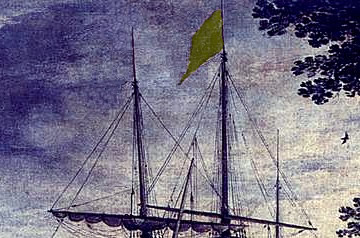
Artist: Paul Bril
Yellow Flag at Top Mast Head (Note: Original Image Altered)
College of Physicians' Directions for the Cure of the Plague ordered houses containing infected individual were to be "shut up, with a large red Cross, and Lord have Mercy upon us on the Door; and Watchmen attending Day and Night to prevent any one's going in or out, except Physicians, Surgeons, Apothecaries, Nurses, Searchers, &c. allowed by Authority: And this to continue at least a Month after all the Family was dead or recovered."29
At sea, however, the situation was different. Many people associate a yellow quarantine flag with vessels serving quarantine. However, quarantine ships during this period were not identified by any particular symbol. The description of this well-known 'yellow jack' didn't appear in England until the Quarantine Act of 1788. This act specified that such ships were "to hoist a particular signal, to denote that this vessel is liable to quarantine; such signal, for the day time, to be a large yellow flag at the main top-mast head; and, for the night time, to be a light at the same mast-head"30. This was still more than 60 years in the future at the end of the golden age of piracy. Ships were only known to other ships to be in quarantine by the fact that they were anchored in the locations specified for that purpose.
1 Patrick Russell, A Treatise on the Plague, Vol. 2, 1791, p. 325; 2 Neville M Goodman, International Health Organizations and Their Work, 1971, p. 12; 3 John Booker, Maritime Quarantine: The British Experience c. 1650 -1900, 2007, p. 30; 4 Her Majesty's Public Record Office, Calendar of State Papers, Domestic Series, of the Reign of Charles I, 1635, John Bruce, ed., 1865, p. 443-4; 5 Booker, p. 3; 6 Booker, p. 4; 7 Patrick Russell, A Treatise on the Plague, Vol. 2, 1791, p. 318; 8 Samuel Pepys, The Diary of Samuel Pepys, November 26th, 1663 entry; 9 John J. Keevil, Medicine and the Navy 1200-1900: Volume II – 1640-1714, 1958, p. 187-8; 10 Russell,p. 323; 11 Goodman, p. 31; 12,13 Booker, p. 30; 14 Great Britain and Owen Ruffhead, Statutes at Large, Vol. 4, (1699-1713), 1763, p. 420-1; 15 Booker, p. 38; 16 Booker, p. 48; 17 Booker, p. 39 & 85; 18 Booker, p. 88; 19 Booker, p. 94; 20 Russell, p. 442; 21,22 Great Britain and Owen Ruffhead, Statutes at Large, Vol. 5, (1714-1728), 1763, p. 330; 23 Booker, p. 107-8; 24,25 Booker, p. 102; 26,27 Booker, p. 109; 28 Carlo M. Cipolla. Cristofano and the Plague, 1973, p. 30; 29 Richard Mead, A short discourse concerning pestilential contagion, 4th ed, 1720, p. 32-3; 30 Great Britain and Danby Pickering, Statutes at Large, Vol. 36, (1787-1789), 1761, p. 379
History of Quarantine Regulations - Bubonic Plague: Richard Mead's Proposals
As mentioned in the previous section, Richard Mead wrote a book which proposed rules for quarantine in England called A short discourse concerning pestilential contagion. His ideas were clearly drawn from those in use at the lazarettos in Italy,

Richard Mead, Wellcome Collection
France and Portugal, which in turn came from those established by the Venetian Republic. Since these suggestions were never employed, a thorough review of them here would be pointless. However, an outline of the more interesting ideas he presented is worth briefly discussing.
Mead proposed building lazarettos "in convenient Places, on little Islands if it can so be, for the Reception both of Men and Goods, which arrive from Places suspected of Infection"1. He notes that shipboard quarantine is not as effective as quarantine in a lazaretto. He felt that when dealing with foul or infected ships, the 'sound men' should be removed to a lazaretto and their clothes "should be burnt; the Men washed and shaved; and having fresh Cloaths, should stay in the Lazaretto 30 or 40 Days."2 Those who were ill on the ship were likewise to be sent to the lazaretto, but placed in separate quarters until they were well. Once healthy, they could start their stay of thirty to forty days in quarantine with the 'sound men'. Men from ships with clean bills of health need not serve time in quarantine, although they "they may be washed, and their Cloaths aired in the Lazaretto, as Goods, for one Week."3
Mead says that "the greatest Danger [of infection by the plague] is from such Goods, as are apt to retain Infection, such as Cotton, Hemp and Flax, Paper or Books, Silk of all sorts, Linen, Wool, Feathers, Hair, and all kinds of Skins."4 He advised setting up separate lazarettos "at a Distance from that for the Men, and they must in convenient Warehouses be unpackt, and exposed, as much as may be, to the fresh Air for 40 Days."5 He further states that "Goods should be open’d, when they are put into the Lazaretto, otherwise their being there will avail nothing."6 When ships came from places which were known to have the plague, "it will be the securest Method to Burn all the Goods, and even the Ship."7
Not everyone was a fan of Mead's ideas. In 1721, London physician George Pye wrote a book called A Discourse of the Plague subtitled "Wherein Dr. Mead's Notions are Consider'd and Refuted." (It was not uncommon for medical men during this period to write books focused on discrediting the work of other medical men.) Pye's disagreement with Mead stemmed from his theories of propigation of the illness,
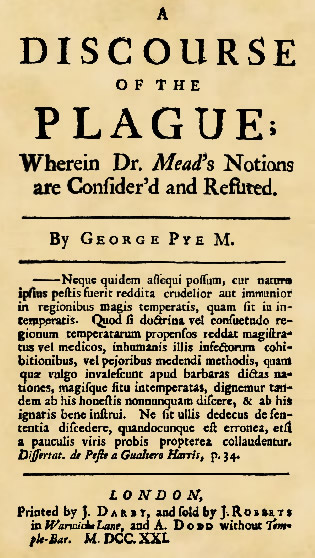
George Pye's Book A Discourse of the Plague (1721)
something that was not understood until long after the golden age of piracy. A section of Pye's book states: "the Plague is not propigated by means of Goods"8, indicating that a lazaretto dedicated solely to airing goods was pointless. He also says that even if people in quarantine managed to rid themselves whatever caused the plague during their quarantine, would pick it up again from others in the lazaretto who had not yet been there for the full forty days.9 (Mead does not go into much detail about keeping passengers separate within the lazaretto in the way that the Mediterranean lazarettos did, other than suggesting those who were ill should be kept away from those who are 'sound'.) Pye also points out that other places employing quarantine had failed to prevent infection, specifically mentioning Marseille.10
Pye finishes his argument against quarantine with a flourish, appealing to the independence and the pocket book of their nation.
Why do People run the Risque and Danger of the Seas, but because they hope thereby to provide against the greater Evils of Poverty and Want, or else to gain Riches and Wealth, which may seem a Good more than equal to the Risque and Danger? Wherefores tho the Plague be an Evil much to be dreaded, yet if the Measures necessary for the securing us from it must occasion more and greater Evils, it may be most adviseable to run the risque of the Plague, rather than submit to such hard Measures. Now as it cannot be doubted but the enforcing Quarantanes in a trading Nation, must occasion many and great Inconveniencies and Evils; these should be consider'd as well as the Good we may thereby hope to have secur'd to us.11
He goes on: "The plague may possibly destroy a hundred thousand lives; but the loss of trade may starve and destroy ten times a hundred thousand; for Quarantines will load our foreign commerce with such hardships, and embarrass it with such insuperable difficulties as will very much discourage trading, and very greatly diminish it."12 The balance between safety against a health problem was not well understood and the freedom of trade was typically at the root of concerns about quarantine. However, for all his wordsmithing, Pye had little influence on the end result. Modern historian John Booker explains that Pye's complaints "were published too late to affect Privy Council policy for the first year of the crisis, They were, however, to be most important in the long run as the wisdom and effectiveness of quarantine, cornerstone of plague defence, was now under attack."13
1 Richard Mead, A short discourse concerning pestilential contagion, 1720, p. 21; 2 Mead, p. 22; 3,4 Mead, p. 24; 5 Mead, p. 25; 6 Mead, p. 26; 7 Mead, p. 28; 8 See George Pye, A Discourse of the Plague, 1721, pp. 36-43; 9 Pye, p. 45; 10 Pye, p. 48; 11 Pye, p. 50-1; 12 Pye, p. 50; 13 John Booker, Maritime Quarantine The British Experience c1650-1900, 2007, p 91

